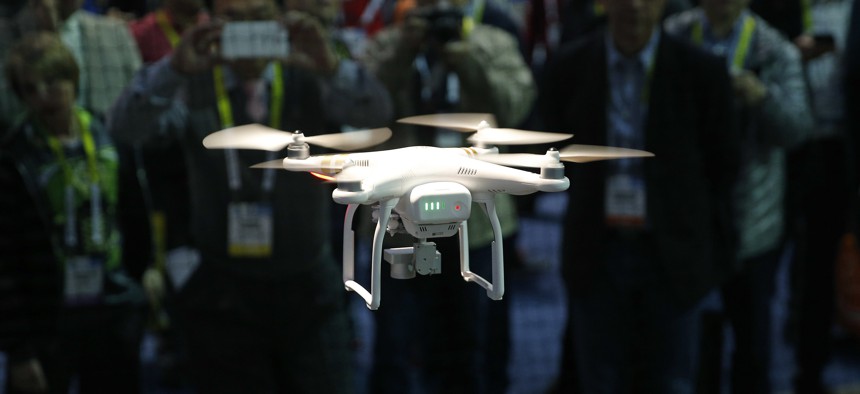
In this Jan. 7, 2016, file photo, a drone hovers at a booth during CES International, Thursday, Jan. 7, 2016, in Las Vegas. John Locher/AP
All of Cleveland Will Be a 'No Drone Zone' for the GOP Convention
The Secret Service says the rule—which covers 82.47 square miles of land and water—is just business as usual.
The city of Cleveland is gearing up for the invasion of 50,000 GOP conventioneers and assorted visitors next week and–despite the city’s clear ability to handle a crowd–it has issued tight security restrictions to ensure nothing goes awry during the controversial coronation of Donald Trump as the Republican nominee for president.
In a recent press release, 29 federal, state and city agencies listed the expected road closures and traffic restrictions for a major event like the Republican National Convention (RNC). Access to the Rock and Roll Hall of Fame, Voinovich Park, and Great Lakes Science Center between 12:01 am Sunday July 17 and 1 am Monday July 18 will be limited, for instance, and Burke Lakefront Airport, located downtown along the shore of Lake Erie, will only be open to private aircraft.
Then there are the drones.
The entire city of Cleveland–82.47 square miles of land and water– is a no drone zone. According to the release:
Cleveland, OH and surrounding communities are No Drone Zones under the FAA flight restrictions for the RNC and local ordinances. Flying a drone in any of the designated restricted areas is against the law. Any unmanned aircraft–including radio-controlled model aircraft / UAS (unmanned aerial system)–are prohibited in the designated restricted areas. Anyone flying a drone within the designated restricted areas may be subject to civil and criminal charges.
“Surrounding communities” may include hotel areas in Cleveland suburbs, which would make the no drone zone big enough to encompass at least five counties in Northeast Ohio. Kids, put away those toy airplanes in the backyard, please.
The US Secret Service, which has jurisdiction over the RNC, says the no drone rule is simply part of its usual security planning. “I can’t elaborate on why drones are not authorized in the area, other than security reasons,” says Nicole Mainor, a spokeswoman for the agency.
Authorities are becoming more worried about drones (paywall) that can be used by terrorists and criminals; some can be equipped with guns or chemical weapons. Last year a 2.8 pound drone on a recreational flight accidentally crashed on the White House lawn. The police use of a robot to kill the Dallas sniper last week has called into question the ability to use remote devices to inflict harm. And, of course, there’s the controversial use of military drones deployed by the Obama administration to kill terrorists overseas.
The rapidly falling cost of drones have made them accessible to those who want to use them as weapons or carriers of contraband such as drugs. The latest drone model from China’s Xiaomi sells for just $380.
Still, the US sees drones as a potential new industry that could generate more than $82 billion for the US economy and create more than 100,000 new jobs over the next 10 years. The FAA has proposed new commercial drone rules, which go into effect on Aug. 29. Among other things, drone pilots must be at least 16 years old and pass a FAA-approved test or have a pilot’s license and complete an FAA training course. Pilots must be vetted by the Transportation Security Administration and be able to see their drone while it’s in flight. There aren’t any specific rules on privacy.
Drones were a source of controversy during the last Republican convention, held in 2012 in Tampa. Then, they were seen as a security device, not a risk.
City police wanted a couple surveillance cameras mounted on drones, but locals objected. “There were significant privacy concerns associated with the use of drones over America’s back yards,” John Dingfelder, a former Tampa city councilman, told the Tampa Bay Times. Police eventually dropped the idea because of costs, the newspaper said. “Well, obviously, we are in a much different environment in 2015 than 2012,” says Mainor of the Secret Service.



